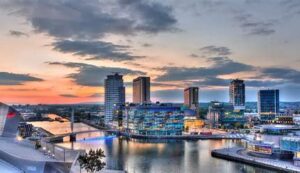Guest Blog, Placemaking, by Robert Hough NWBLT Life President
For some time now, I have been reflecting about the concept of Place, one of those words that is easy to say, but much more difficult to define; but equally well, when you encounter Place, you immediately recognise it.
The evolution of Place or its adjunct, Placemaking, is a concept which has developed over the last 30 years or so and now plays an important role in regeneration and development.
CONTEXT
Placemaking at its most common level is about improving the quality of public space and the lives of the people who use it. It can often have the additional benefit of creating pleasure, engendering pride and connecting neighbourhoods, so providing a wider catalyst for regeneration.
It is certainly easier to describe the qualities of Place rather than be definitive about the precise components. For example, a Place will have character and distinctiveness and will connect with its residents and visitors. It is often about lively neighbourhoods and inviting public spaces.
It could also typically provide new or rediscovered public areas; or else it could create refreshing vitality through improvements to streets, squares, playgrounds or parks.
A Place scheme could perhaps involve:
- the introduction of a public realm landscape project attached to a high quality commercial development; or
- a community led scheme developed by local neighbourhood groups (say, a landscaping scheme), which creates a sense of Place, unity and pleasure; or
- an individual substantial hybrid scheme like Mayfield in Manchester, which is a
24 acre brownfield site filled with heritage and the River Medlock flowing through its core, but which was a derelict site and is being revived into an exciting mixed-use neighbourhood.
CONTENT AND QUALITIES
So, at one level, perhaps Place means no more than a particular location that is distinctive and appealing, accompanied by open areas of entertainment, or by space for relaxation and attractive architecture, where people can enjoy themselves.
Alternatively, places like Albert Dock in Liverpool or Castlefield in Manchester have established their own individual sense of Place through restoration and now have scale and brand identity.
They promote happiness and wellbeing, laced with fun, enjoyment, pleasure and probably memories. People will feel comfortable and reminisce, places where on-site activities bring quality to the locality and pleasure to the visitors. In that context, it is a self-fuelling phenomenon, providing mutual benefit.
In another form, Placemaking can create something new and substantial, even dramatic – a classic example being the old Manchester Docks, now the home of MediaCity with BBC, ITV, 1.4m sq ft of offices and over 5,000 jobs and 1,000 new homes, The Lowry, Imperial War Museum and Salford University and multiple other companies. The space, the heritage, the backdrop and the quality provide that sense of Place.
1.4m sq ft of offices and over 5,000 jobs and 1,000 new homes, The Lowry, Imperial War Museum and Salford University and multiple other companies. The space, the heritage, the backdrop and the quality provide that sense of Place.
EXTENDED REACH
From my own perspective, I tend to extend my perception of Place beyond just being an area which is distinctive or reborn. I feel that a whole town or village can provide the qualities that Place demands and satisfies. I always think of Stockton Heath, near Warrington, as a village, which has character and pride – nothing fancy, but appealing, with its range of shops and restaurants, its proximity and history through the presence of the Manchester Ship Canal, the Bridgwater Canal and lovely public gardens nearby. I also suppose that a sense of Place can arise because of the personal bond and attachment that people develop or experience from a particular location. Perhaps subconsciously, that is why I consider Stockton Heath to have a sense of Place.
So also, for me, the mill towns of East Lancashire with their history, durability, fortitude and their strong architectural character and grit qualify in terms of providing a sense of Place. They are Places which have heart and soul and often, for me, reflections of the present and also great memories of the past. They have special and enduring attributes.
The City of Liverpool with its wonderful history, majestic buildings, open spaces and splendid parks provides a perfect example; and similarly for me, but for different reasons, so would Formby, as an attractive town and with its exceptional beach and coastline, surrounded by forest and home to rare nature and wildlife species and an outlook over the Irish Sea – and, if one is fortunate to witness a huge container ship heading for the Port of Liverpool.
Formby, as an attractive town and with its exceptional beach and coastline, surrounded by forest and home to rare nature and wildlife species and an outlook over the Irish Sea – and, if one is fortunate to witness a huge container ship heading for the Port of Liverpool.
FUNDING
Creation of a sense of Place may well require substantial funding. It is often attached to major schemes, where the Place activities are part of the planning condition and can be delivered from the financial framework of the scheme. If it is allied to a substantial commercial project, then the necessary capital to fund and support a Placemaking project may well flow from the developer.
The European Structural and Investment Funds programme prior to the UK’s exit from the European Union was a major source of funding for public realm schemes in town and city centres in North West England. The North West Regional Development Agency had an important role during its tenure in ensuring this happened effectively. How we now miss those funds and what a great Placemaking support role they performed.
Post-Brexit, the UK Shared Prosperity Fund was trailed as the successor, but from my line of sight, has not delivered substantively and probably never will. That sadly leaves a funding gap for future schemes that provide the sense of Place. It is difficult to see that funding coming from hard-pressed Local Authority budgets. Such is the impact of progress, change and unintended consequences.
For this, it requires funding to create the infrastructure, the setting, the landscaping, the ambience and street scenes and to maintain all of them thereafter.
In the context of hard-pressed Local Authorities and the absence of European Funding, it is perhaps realistic to acknowledge that the great Placemaking schemes of the future will often have to be linked to private sector commercial development.
That consequence may leave a substantial vacuum for providing an increased sense of Place in our town centres, but I hope that I am wrong. Perhaps the new Government should and will bridge the financial gap for this important issue?
REJOICE AND ENJOY
In the meantime, let us rejoice at the pleasures and memories that Placemaking in the North West has provided. Long may it prosper. Its benefits create enjoyment for us all. It should never be diluted nor forgotten.